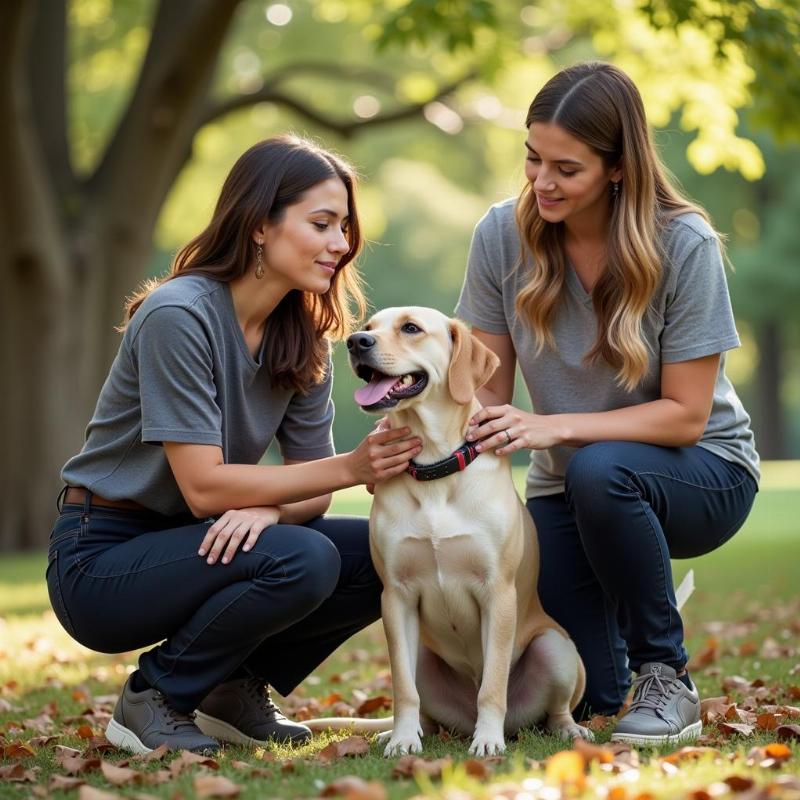Barking at strangers is a common canine behavior, often stemming from territorial instincts or fear. While some barking is normal, excessive barking can be disruptive and problematic. Fortunately, with patience, consistency, and the right approach, you can teach your dog to greet strangers calmly and confidently. This guide will provide you with proven techniques and expert advice to help you achieve a peaceful, bark-free environment.
Understanding Why Dogs Bark at Strangers
Before diving into training, it’s crucial to understand the underlying reasons for your dog’s barking. Is it fear, territoriality, excitement, or a learned behavior? Identifying the root cause will help you tailor your training approach for maximum effectiveness. For instance, a fearful dog requires a different approach than a dog who barks out of excitement. Consider consulting with a certified professional dog trainer or veterinarian behaviorist for a personalized assessment. They can help you pinpoint the triggers and develop a customized training plan.
Desensitization and Counter-Conditioning: A Gradual Approach
Desensitization and counter-conditioning are effective methods for addressing fear-based barking. This involves gradually exposing your dog to strangers at a distance while pairing the presence of strangers with positive experiences, like treats or toys. Start with a distance where your dog doesn’t bark and gradually decrease the distance over time. The goal is to change your dog’s emotional response from fear or anxiety to a positive association with strangers.
“Quiet” Command Training: Teaching an Alternative Behavior
Teaching a “quiet” command gives your dog an alternative behavior to barking. Start by saying “quiet” when your dog barks, and immediately reward them with a treat when they stop, even for a brief moment. Consistency is key here. Practice this command in various situations, gradually increasing the duration of silence before rewarding.
Positive Reinforcement: Rewarding Desired Behavior
Positive reinforcement is the cornerstone of effective dog training. Instead of punishing barking, focus on rewarding calm and quiet behavior. When your dog greets a stranger calmly, offer praise, treats, or a favorite toy. This reinforces the desired behavior and motivates your dog to repeat it.
Managing the Environment: Limiting Barking Triggers
Sometimes, managing your dog’s environment can significantly reduce barking. If your dog barks at strangers passing by the window, try closing blinds or curtains. Create a safe space for your dog where they can retreat and feel secure when overwhelmed. This could be a crate, a bed, or a quiet room.
Seeking Professional Help: When to Consult an Expert
If your dog’s barking persists despite your efforts, consider consulting with a certified professional dog trainer or a veterinary behaviorist. They can assess your dog’s behavior, identify underlying issues, and develop a tailored training plan. They can also offer guidance on behavior modification techniques and address any specific challenges you may be facing.
 Dog Training Consultation
Dog Training Consultation
Conclusion
Teaching your dog not to bark at strangers requires patience, consistency, and a positive approach. By understanding the underlying causes of barking, implementing desensitization and counter-conditioning techniques, and utilizing positive reinforcement, you can help your dog develop calm and confident interactions with strangers. Remember, creating a positive and rewarding learning environment is crucial for success. With dedication and the right tools, you can achieve a harmonious relationship with your dog and enjoy a peaceful, bark-free home.
FAQ
- How long does it take to teach a dog not to bark at strangers? The time it takes varies depending on the dog’s age, temperament, and the consistency of training. It can take weeks or even months to see significant progress.
- What if my dog is aggressive towards strangers? If your dog exhibits aggression, consult with a professional dog trainer or veterinary behaviorist immediately. They can assess the situation and recommend appropriate interventions.
- Is punishment effective in stopping barking? Punishment is generally not recommended, as it can worsen fear and anxiety, leading to more problematic behaviors.
- Can I use a bark collar to stop my dog from barking? While bark collars can suppress barking, they don’t address the underlying cause and can be aversive. It’s best to focus on positive reinforcement and training methods.
- What if my dog only barks at certain types of strangers? This could indicate a specific fear or trigger. Observe your dog’s behavior closely to identify patterns and address them accordingly.
- Should I introduce my dog to every stranger I meet? Not necessarily. Focus on controlled introductions in calm environments to build your dog’s confidence gradually.
- What if my dog barks at strangers even when on a leash? Keep the leash short and maintain control, rewarding your dog for calm behavior when strangers approach.
Related Articles on Beautdogs.us:
- How to train a dog to not bark at strangers
- How to make my dog stop barking at strangers
- How to teach a dog not to bark at strangers
- I’ve tried everything and my dog won’t stop barking
At Beautdogs.us, we’re dedicated to providing expert advice and resources for dog owners across America. We offer comprehensive information on dog breeds, care, training, and products, catering to both novice and experienced dog owners. Our mission is to empower you with the knowledge and tools to build a strong, loving bond with your canine companion. Contact us today for personalized support: Email: [email protected], Phone: +1 501-555-7529.